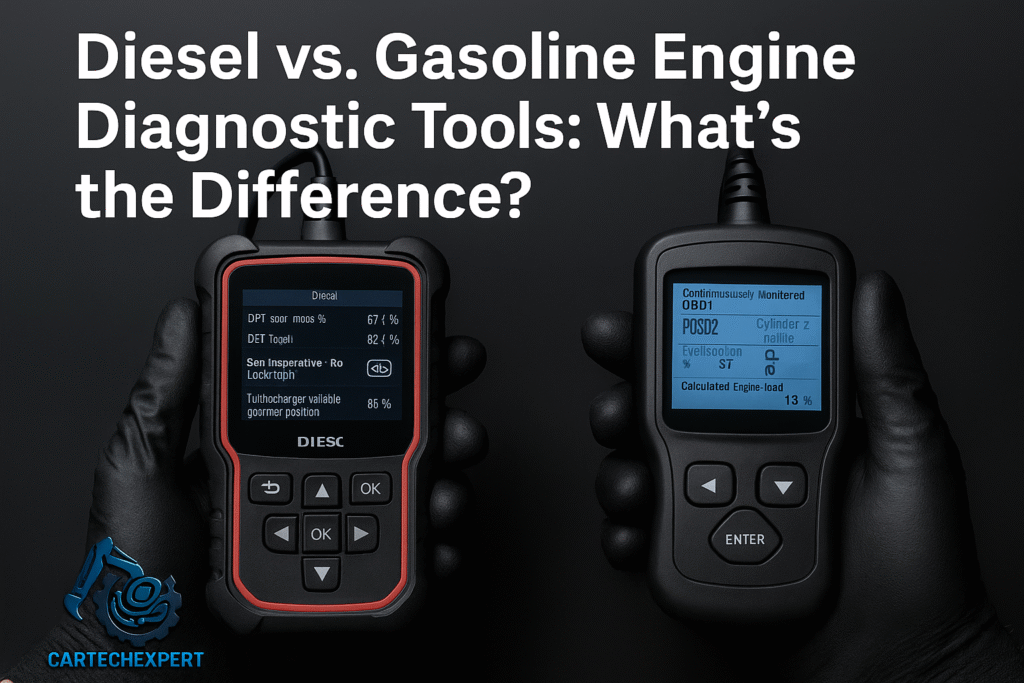Physical Address
Arthur Avenue , BrookField , ILLINOIS , 60513 , United State
Physical Address
Arthur Avenue , BrookField , ILLINOIS , 60513 , United State

You’ve been there—standing in the workshop, staring at your tool’s screen, trying to make sense of cryptic fault codes. You’ve plugged your scanner into that diesel rig or your daily driver’s OBD-II port, hoping for clarity. Yet somehow the data doesn’t match, and your confidence dips. The reason? You might be using the wrong diagnostic tool for the engine in front of you.
In the world of automotive and heavy‑equipment diagnostics, tools aren’t one-size-fits-all. The oil‑burning giants of the diesel world and the spark‑ignited gasoline engines operate on fundamentally different systems. That means their diagnostic requirements and data streams are also worlds apart. Understanding the nuances between diesel and gasoline engine diagnostic tools isn’t just academic—it’s practical. The right tool saves you time, builds trust with your clients, and prevents costly misdiagnoses.
Let’s dive in—by the end, you’ll confidently know what scanner to choose, when, and why.
Diesel diagnostics focus on emissions, injector pressure, and turbo systems. Gasoline diagnostics target ignition, mixture control, and fuel trims.
Using a gasoline scanner on a diesel engine might return no codes—because it can’t interpret J1939 or other diesel protocols.
| Feature | Diesel Tools | Gasoline Tools |
|---|---|---|
| Emission Capabilities | DPF regen, DEF level, SCR operation | Catalytic converter, EVAP readiness |
| Data Depth | Injector pressure, turbo boost | Misfires, fuel trims, O₂ sensors |
| Bi-Directional Control | Regen, injector coding, turbo tests | Limited to ignition and fuel actuations |
| Probes & Diagnostics | High-temp/pressure sensors | Basic voltage and resistance tools |
| Feature | Diesel Tools | Gasoline Tools |
|---|---|---|
| Vehicle Type | Heavy-duty, commercial, agricultural | Cars, SUVs, light trucks |
| Protocols | J1939, J1708 | OBD-II (CAN, ISO, etc.) |
| Emissions Focus | DPF, SCR, NOx sensors | EVAP, catalytic converter, O₂ sensors |
| Tool Examples | Jaltest, Texa, CAT ET | Autel, Launch, Bosch |
| Price Range | $1,500–$4,500+ | $120–$2,000 |
| Best For | Fleets, diesel techs, pro repair | DIYers, auto shops, car techs |
They’re built by engine manufacturers to ensure complete system access and offer advanced diagnostics and programming.
They’re versatile and budget-friendly but may miss deeper brand-specific data or updates.
If you work on heavy trucks or manage a fleet, invest in OEM or pro-grade diesel scanners. It will save you time, build trust, and prevent misdiagnoses.
Visit our CARTECHEXPERT Store to explore professional-grade OEM and universal diagnostic tools tailored for diesel and gasoline vehicles.
Yes—premium tools like Autel Maxisys Elite do, but they’re pricier.
They need advanced hardware/software to handle emissions systems like DPF/SCR and diesel protocols.
No—it reads OBD-II only and won’t capture J1939 codes.
Every 1–3 months or when new vehicle models/protocols are released.
If you deal with mixed fleets or want reliable data—absolutely.